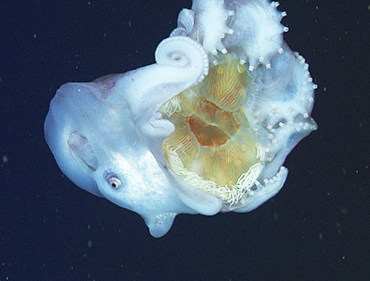Jelly Belly: Elusive Deep Sea Octopus Takes Its Gelatinous Meals To Go
Posted on Categories Discover Magazine

A female seven-arm octopus carrying an egg-yolk jelly. Photo © MBARI
The seven-arm octopus, Haliphron atlanticus, lives a hidden life deep in the dark depths of the oceans. These massive cephalopods—females of which can grow to be more than 12 feet long—earned the moniker for their habit of folding one of their eight arms away. What little is known of their daily lives has largely been gleaned from dead animals pulled from the sea by trawls, as inhabitants of the deep sea, their activities are nearly impossible to observe. Now, a new paper in Scientific Reports provides insights into their diet and behavior, finding they prefer to dine on species we tend to think of as less than palatable: jellyfish.
Scientists from the GEOMAR Helmholtz Centre for Ocean Research Kiel and Monterey Bay Aquarium Research Institute (MBARI) used remotely operated vehicles (ROVs) to explore the dark depths between 800 and 1700 feet below the surface to video the species that persist in these habitats alive. In 27 years of deep sea research, they only spotted three living octopus. The most recent footage, taken in July 2013, was so surprising that they re-examined every old video and museum specimens for further evidence of what it depicted: a diet of jellyfish.
The video, taken at a depth of about 1240 feet in the Monterey Submarine Canyon, shows a large female octopus carrying a large egg-yolk jelly (Phacellophora camtschatica) in tucked in her arms. When she spread her arms, the scientists were able to see her beak had bitten through the jelly’s bell from the outside, likely killing the animal. It was unclear if she was holding onto her dinner to continue to consume it, or, if she was repurposing the animal’s potent tentacles for her own use. The scientists propose that the carrying behavior may not be dining and dashing, but rather, the octopus could be using the tentacles of the jelly to either defend herself against potential foes or ensnare additional meal items. Such a behavior would not be unheard of—one close relative of Haliphron, the blanket octopus, suctions Portuguese man-of-war tentacles to its arms for similar uses.
When the scientific team examined older footage, they found two more sightings of Haliphron atlanticus; in one video, the octopus was clutching an unidentifiable gelatinous creature, and in the other, the octopus was holding a “yellow mass” that was never revealed—so in both cases, similar behaviors could have been occurring. Then, in the stomachs of five museum specimens, they identified tentacle fragments and other remains from siphonophores and salps, affirming that this species of octopus feeds on jellies and other gelatinous creatures.
Haliphron‘s affinity for jellies fits right in with what we know of its relatives. As a member of the superfamily Argonautoidea, it is closely related to several octopus species known to associate with gelatinous creatures. Small and young blanket octopus males (Tremoctopus gracilis) were first observed with the stinging tentacles of Portuguese man o’ war suctioned to their tentacles in the late 1950s. It was speculated that these stinging fragments were for offense, defense, or both, potentially. The football octopus (Ocythoe tuberculata) makes its home inside salps, likely using the gelatinous walls as a refuge from predators and possibly snacking on tidbits that flow through the salp as it pumps water through its tissues. And most intriguingly, the paper nautilus (Argonauta sp.) have been observed dining on jellies and whatever food they contain in their digestive cavities using the very same bell-grabbing and biting maneuver.

Paper nautiluses also grab jellies by the bell and pierce into them using their sharp beaks. Photo © Thomas Heeger, via Tree of Life
Outside of this group of octopus, there are other species that feed on venomous jellies and other gooey ocean critters. Notable diners include sea turtles, ocean sunfish, and somewhat distant cousins of the octopus, nudibranchs, which will consume jellies and other cnidarians while somehow keeping their stinging cells in tact so they can be repurposed for the nudibranch’s defense. Our species, too, has been known to delight in jellies; in some parts of the world, these jello-esque creatures are considered a delicacy. Many scientists think that the overall number of species that eat gelatinous animals may be grossly underestimated, as without hard parts, their soft bodies are quickly digested and easy to overlook in stomach content analyses.
This discovery provides a clearer picture of the food web in these hard-to-observe habitats. Scientists have long known that sperm whales, sharks, and swordfish consume these large, deep sea octopus, so understanding the octopus’ diet helps them connect the dots between smaller oceanic species and the largest predators of the deep.
Citation: Hoving, H.J.T. and Haddock, S.H.D. (2017) The giant deep-sea octopus Haliphron atlanticus forages on gelatinous fauna. Sci. Rep. 7, 44952; doi:10.1038/srep44952.